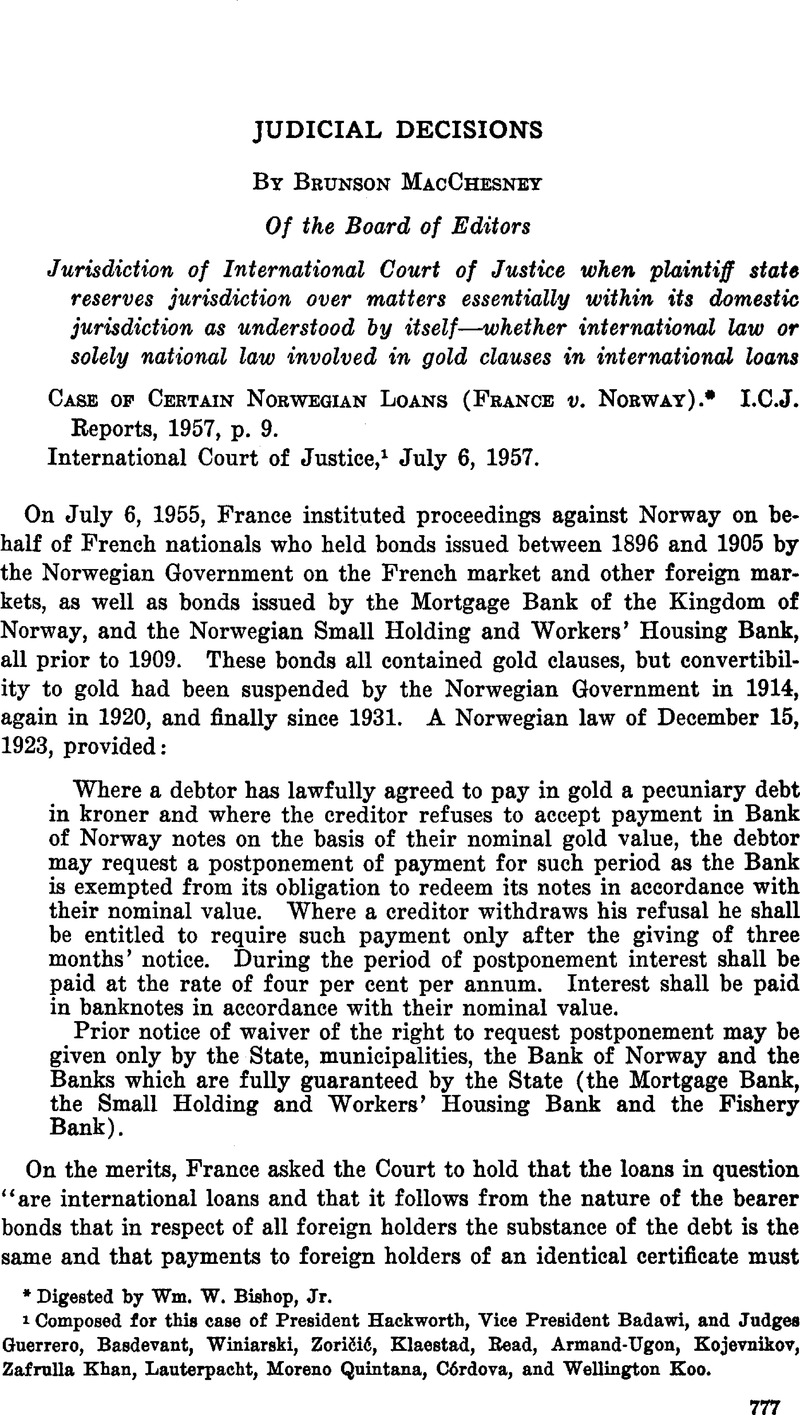Article contents
Case of Certain Norwegian Loans (France v. Norway)
Published online by Cambridge University Press: 28 March 2017
Abstract

- Type
- Judicial Decisions
- Information
- Copyright
- Copyright © American Society of International Law 1957
References
* Digested by Wm. W. Bishop, Jr.
1 Composed for this case of President Hackworth, Vice President Badawi, and Judges Guerrero, Basdevant, Winiarski, Zoričić, Klaestad, Read, Armand-Ugon, Kojevnikov, Zafrulla Khan, Lauterpacht, Moreno Quintana, Córdova, and Wellington Eoo.
2 In the course of the arguments it was asserted that in fact Danish and Swedish bondholders received more favorable treatment than did French.
3 The well-known “Optional Clause,” which provides that: “The states parties to the present Statute may at any time declare that they recognize as compulsory ipso facto and without special agreement, in relation to any other state accepting the same obligation, the jurisdiction of the Court in all legal disputes concerning:
“a. the interpretation of a treaty;
“b. any question of international law;
“c. the existence of any fact which, if established, would constitute a breach of an international obligation;
“d. the nature or extent of the reparation to be made for the breach of an international obligation.”
4 In force for five years from deposit of ratification, and thereafter until contrary notice given by the French Government.
5 He found it contrary to Art. 36 (6) of the Statute; to a fundamental principle of jurisprudence that it is “within the inherent power of a tribunal to interpret the text establishing its jurisdiction”; and to Art. 1 of the Statute and Art. 92 of the U.N. Charter, both requiring the Court to function in accordance with its Statute. On this he added: “In accepting the jurisdiction of the Court Governments are free to limit its jurisdiction in a drastic manner. As a result there may be little left in the Acceptance which is subject to the jurisdiction of the Court. … But the question whether that little that is left is or is not subject to the jurisdiction of the Court must be determined by the Court itself. Any conditions or reservations which purport to deprive the Court of that power are contrary to an express provision of the Statute and to the very notion, embodied in Article 36 (6), of conferment of obligatory jurisdiction upon the Court. As such they are invalid.”
6 He deemed the Acceptance containing the reservation to be “invalid as lacking in an essential condition of validity of a legal instrument. This is so for the reason that it leaves to the party making the Declaration the right to determine the extent and the very existence of its obligation. The effect of the French reservation relating to domestic jurisdiction is that the French Government has, in this respect, undertaken an obligation to the extent to which it, and it alone, considers that it has done so. This means that it has undertaken no obligation. An instrument in which a party is entitled to determine the existence of its obligation is not a valid and enforceable legal instrument of which a court of law can take cognizance. It is not a legal instrument. It is a declaration of a political principle and purpose.”
7 He distinguished the acceptance by the Court of jurisdiction in the Case Concerning Eights of Nationals of the United States of America in Morocco, [1952] I.C.J. Rep. 176, digested in 47 A.J.I.L. 136 (1953), on the ground that there neither state contested jurisdiction, and that in effect the case was brought before the Court by agreement of the parties rather than under Art. 36 (2) of the Statute.
- 2
- Cited by




